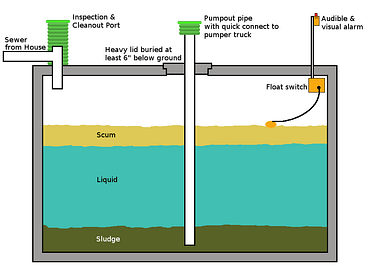Risers bring the lid of the septic tank up to ground level for easier access by your service company for inspection, pumping, and waste removal.
Installing a riser may cost one-time money, but you will quickly recoup this investment through savings on future septic tank maintenance and pump-out expenses.
Cost
Septic tank risers are pipes made of plastic, fiberglass or concrete that create an open portal at ground level to enable easy access to septic systems for inspection and pumping – either exposed or with grass/soil covering over them – for inspection and pumping purposes. Installing risers may even be required by certain local codes for proper functioning of septic systems; you can purchase riser kits that come with instructions to install one yourself easily without professional services needed – though any changes to an existing septic tank/system will need inspection by an inspector from where you reside before making changes alterations.
Installing a riser will not only make maintaining a septic tank easier and reduce pumping costs, but can also cut labor charges significantly. Furthermore, service personnel can simply unlock and access your system by unlatching its lid for easier pumping access.
Step one of determining the cost of installing a septic tank riser is establishing what height you would like your access riser to be. Measure from your access hole on to the ground surface, subtract a few inches for height of riser. Your riser should provide easy cleaning access while being close enough so your inlet/outlet openings can still be easily reached.
Once you know the height that suits you best, the next step should be comparing septic tank riser prices. With many sizes to choose from and costs ranging between $65 to $250, installation can vary significantly in cost depending on which material and size of riser is selected and what installation process takes place.
One final consideration about the cost of septic tank risers is installation. Improper installation could cause leakage or breakage; to ensure they remain leak-free, follow your manufacturer’s instructions regarding testing them – typically, fill your septic tank to 2 inches above its base, wait 30 minutes, then monitor for any potential leaks before watching for their presence or lack thereof.
Durability
Septic tank risers are vertical concrete or plastic pipes that extend vertically from the septic tank’s access ports and pump-out openings up to about ground level, offering easy access for inspection, cleaning and pumping out. Septic tank risers are beneficial both in new installations as well as retrofitting older tanks that have been buried too deeply; their presence makes inspection and cleaning of a septic tank much simpler, as well as providing easy access for pumping the tank more frequently – some local codes even require them for proper functioning sanitary or plumbing purposes!
There are various types of risers available today, such as polyvinyl chloride (PVC), polyethylene, and concrete models. Each has their own set of advantages in terms of durability, cost and installation ease; concrete risers tend to be the strongest yet also the most costly to install while polyethylene risers may leak water or gases over time; PVC risers provide an optimal compromise between price and durability.
Installing a septic tank riser requires careful consideration and requires uncovering and exposing all manholes, inlet and outlet baffle covers as well as manhole covers on all manholes in order to expose all parts. A friend or family member could assist with this job before using a pry bar to lift off the concrete tank lid using pry bars if there is sealant Z along the brim of the tank and using putty knives on any sealant Z’s around it; once these tasks have been accomplished remove old riser before replacing it with new ones!
Risers can be purchased pre-fabricated from septic tank supply companies in diameters ranging from 18″ to 36″, and heights varying between 6″ and 36″. They are suitable for new as well as retrofitting concrete septic tanks; in order to properly install them it’s advisable to unearth all areas of your tank’s top and separate any manholes from its inlet and outlet baffle covers before uncovering all existing manholes as well. Retrofitting risers requires uncovering existing manholes as well as both inlet/outlet baffle covers before retrofitting risers;
Preparing riser joints properly begins in a precast plant. The first riser section should be cast directly into the tank’s top slab or section to ensure continuity between tank and riser, reducing cracking or leaking risks. Next, secure each riser section to its adapter ring using appropriate types and amounts of screws; plastic risers should have their screw holes lubricated with grease to make tightening the screw easier while sealing joints properly.
Safety
Septic tank risers are an integral component of any septic system, providing access to your tank from ground level for safer and simpler maintenance tasks, which ultimately save money in pumping costs and repairs. Both plastic and concrete varieties of risers exist with each having unique advantages that could prove advantageous when looking to cut maintenance costs down the line. They’re also relatively affordable options which makes them an excellent option for homeowners trying to cut back costs over time.
Without a riser, accessing your septic tank is often a difficult and time-consuming task. Digging through two feet of dirt to reach it only adds further difficulty; plus the opening may be blocked with grass or other debris making opening the lid difficult – however a riser helps by raising it to an accessible height for easy opening of the lid.
Septic tank risers make septic system maintenance cheaper and quicker, as well as easier. Made from durable materials and typically measuring 12 to 42 inches wide, they can be easily stacked while their top is fitted with an adapter ring attached via stainless steel screws to the septic tank itself.
Before installing septic tank risers, it is necessary to conduct some measurements. Measure the opening diameter and height from ground level before taking your measurements – this information will allow you to select which risers would best fit with your tank and which come equipped with built-in safety pans to keep children or pets from accidentally falling in.
To protect your family, select a septic tank riser with an adapter ring designed to accept both 20 and 24 inch risers. Secure it to the ring using butyl sealant rope designed to withstand corrosion while withstanding water pressure – be sure that your tank is clean and free of leaks before sealing the riser!
Installation
Risers are vertical pipes made of concrete or plastic that extend vertically from your septic tank’s pump-out openings and access ports up to ground level, where a lid fits securely over it. A riser may vary between one-and two feet in diameter. When installing risers for your system, the appropriate size must be installed; otherwise it could lead to leakage issues while too-small risers could make reaching your tank difficult.
Make sure the riser is slightly larger than your existing tank opening to help ensure a good seal, which prevents soil and water from entering your septic tank. Clean off and clear away dirt around its opening before installing the riser – depending on what kind of septic system you have, installing the riser may take place as part of its construction or just as an extra step after installation.
Ideal, the riser should be cast directly into the tank’s top slab or top section to create continuity and minimize leakage risks. While this is not always feasible, if possible it will ensure watertight connections between tank and riser.
Risers must also withstand loads from tanks, application and surcharge loads at the surface, soil-groundwater interactions and vibrations from vehicles and machinery – among other stresses. Some risers are made of concrete while others may use steel or PVC.
A riser can be installed either above ground, making accessing your septic tank for maintenance and inspection easier, or it can be hidden beneath the surface of the ground. In either instance, however, a grass cover must be placed over it to prevent it from interfering with lawn care activities and potentially opening itself to weathering damage. Ideally, such covers should feature handles that make opening/closing them simple so as to prevent children from accidentally opening it accidentally and to provide security during inspections or maintenance operations.



